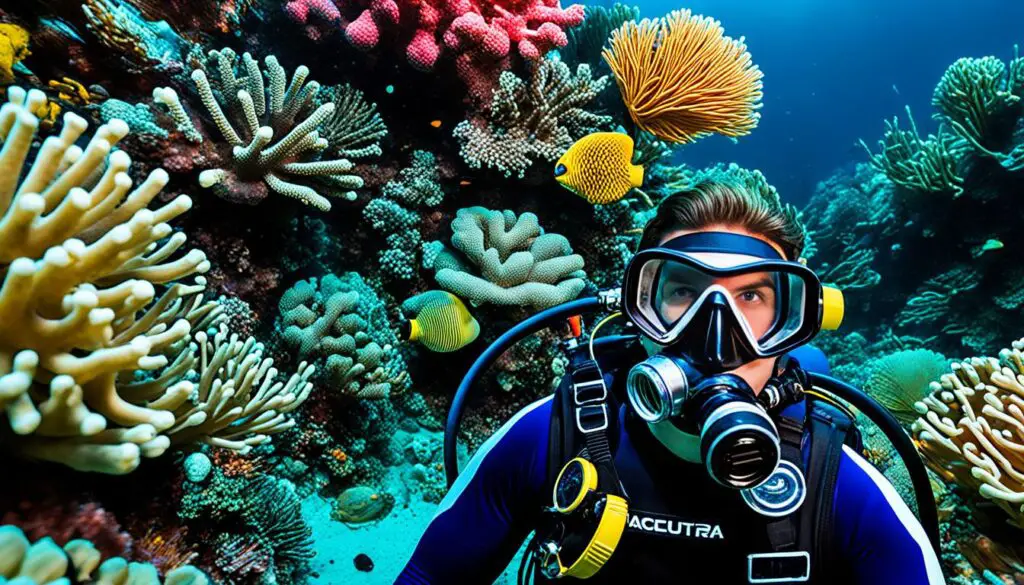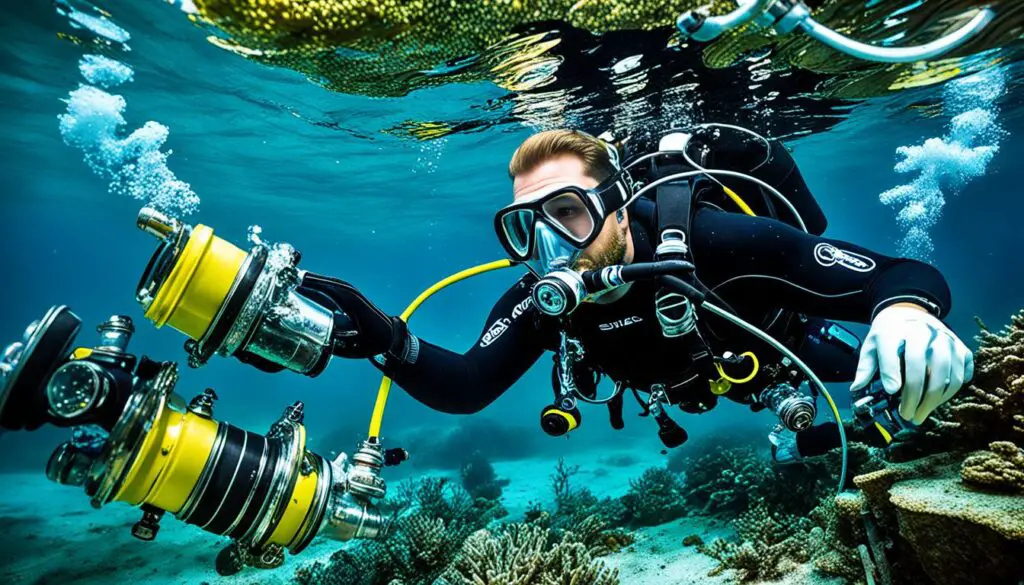Welcome to the first section of our comprehensive guide on dive regulator maintenance. In this section, I will introduce you to the essential aspects of maintaining your dive regulators and why it is crucial for your safety and overall diving experience.
Dive regulators are a lifeline for divers, ensuring a constant supply of air underwater. Just like any other piece of equipment, regular maintenance is key to keeping dive regulators in optimal condition. By properly caring for your gear, you can extend its lifespan and maximize performance, providing you with safe and enjoyable dives for years to come.
Throughout this guide, I will share valuable tips and insights on dive regulator maintenance that will empower you to take better care of your gear. From routine inspections to servicing, we will cover it all, equipping you with the knowledge to keep your dive regulators in top-notch shape.
Key Takeaways:
- Regular maintenance is crucial for dive regulator performance and safety.
- Proper care can extend the lifespan of your dive regulators.
- Throughout this guide, you will learn valuable tips for maintaining your gear.
- Investing time and effort in maintenance will ensure safe and enjoyable diving experiences.
- By following our tips, you can dive with confidence and peace of mind.
Why Diving Regulator Maintenance is Important
Regular maintenance of dive regulators is crucial for ensuring safe and enjoyable diving experiences. By properly caring for your gear, you can extend its lifespan and minimize the risk of accidents or equipment failures underwater. Let’s explore the importance of diving regulator maintenance and the benefits it brings.
First and foremost, dive regulator maintenance ensures that your gear functions properly and is safe to use underwater. By examining and servicing your regulators regularly, you can identify and address any issues before they escalate into major problems. This proactive approach helps prevent equipment malfunctions during dives, giving you peace of mind and enhancing your safety.
Additionally, diving regulator maintenance offers several benefits:
- Reliability: Proper maintenance enhances the reliability of your dive regulators, ensuring that they perform consistently during each dive. This reliability is crucial for your comfort and confidence underwater.
- Performance: Well-maintained regulators deliver optimal performance, allowing you to breathe smoothly and effortlessly while underwater. This enhances your overall diving experience and makes it more enjoyable.
- Durability: Regular maintenance helps extend the lifespan of your dive regulators by minimizing wear and tear. By properly caring for your gear, you can increase its longevity and save money on replacements.
- Resale Value: If you ever decide to upgrade or sell your dive regulators, a well-maintained set will have higher resale value. Buyers are more likely to trust and invest in gear that has been consistently cared for.
“Proper maintenance of dive regulators ensures that they perform reliably, deliver optimal performance, have increased durability, and maintain their resale value.”
Investing time and effort into dive regulator maintenance is essential for every diver. Not only does it enhance your safety and comfort underwater, but it also maximizes the lifespan and performance of your gear. By following the tips in the next section, you can learn how to properly care for your dive regulators and reap the benefits of regular maintenance.
| Benefits of Diving Regulator Maintenance |
|---|
| Enhanced reliability |
| Optimal performance |
| Extended durability |
| Higher resale value |

Tips for Dive Regulator Maintenance
Proper maintenance is key to ensuring the longevity and optimal performance of your dive regulators. By following these dive regulator maintenance tips, you can keep your gear in excellent condition for your underwater adventures.
1. Rinse Your Regulators After Every Dive
After each dive, make sure to thoroughly rinse your dive regulators with fresh water. This helps remove salt, sand, and other debris that could potentially damage the internal components of your gear. Pay close attention to the first stage, second stage, and hoses, ensuring all parts are rinsed and free from any contaminants.
2. Inspect for Damage
Regularly inspect your dive regulators for any signs of damage. Check the mouthpiece, hoses, and connections for cracks, splits, or wear and tear. If you notice any issues, it is important to address them promptly to prevent further damage and potential failure during a dive.
3. Service your Regulators Annually
Professional servicing is essential for the proper maintenance of your dive regulators. Plan to have your regulators serviced by a certified technician at least once a year, or as recommended by the manufacturer. During a service, the technician will disassemble, clean, and inspect the internal components, as well as replace any worn-out parts. This ensures that your regulators are in optimal condition and safe to use.
4. Store Properly
When not in use, store your dive regulators in a cool, dry place. Keep them away from direct sunlight, extreme temperatures, and excessive humidity, as these conditions can accelerate the deterioration of the materials and components. Use a protective case or bag to prevent any accidental impact or damage.
5. Follow Manufacturer’s Guidelines
Always refer to the manufacturer’s guidelines and recommendations for dive regulator maintenance. They provide specific instructions tailored to your gear’s make and model. Following these guidelines ensures that you are giving your regulators the care they need and helps maintain the validity of any warranties.
By implementing these tips for dive regulator maintenance, you can ensure that your gear remains in perfect working condition, extending its lifespan and maximizing your safety and enjoyment underwater.

Conclusion
Proper maintenance of dive regulators is essential for ensuring safe and enjoyable diving experiences. By following these tips and regularly servicing your gear, you can keep your regulators in top condition, extend their lifespan, and dive with confidence.
Remember, the safety and performance of your gear depend on your commitment to maintenance. So, invest the time and effort to care for your dive regulators and enjoy many great dives ahead.
FAQ
Why is regular maintenance of dive regulators important?
Regular maintenance of dive regulators is important because it ensures that your gear is functioning properly and is safe to use underwater. By inspecting and servicing your regulators regularly, you can identify and fix any issues before they become major problems. This helps prevent equipment failures during dives and minimizes the risk of accidents or injuries.
How often should I service my dive regulators?
It is recommended to service your dive regulators at least once a year or as specified by the manufacturer. However, if you dive frequently or in harsh conditions, more frequent servicing may be necessary. Consult the manufacturer’s guidelines for specific recommendations based on your diving habits.
Can I clean my dive regulators myself?
While it is possible to clean your dive regulators yourself, it is recommended to have them serviced by a qualified technician. They have the knowledge and tools to properly clean and inspect all the components of your regulators to ensure they are in optimal condition. This will help maintain their performance and extend their lifespan.
How should I store my dive regulators?
When not in use, it is important to store your dive regulators in a clean and dry environment. Rinse them thoroughly with fresh water after each dive to remove any salt or debris, and make sure they are completely dry before storing. Keep them in a protective case or bag to prevent damage and store them away from direct sunlight or extreme temperatures.
Can I use my dive regulators for other activities besides scuba diving?
Dive regulators are specifically designed for scuba diving and are not recommended for use in other activities. Different activities may require different types of regulators with specific features. Using dive regulators for activities they are not designed for can lead to equipment malfunctions and compromise your safety. It is best to use the appropriate gear for each activity.
